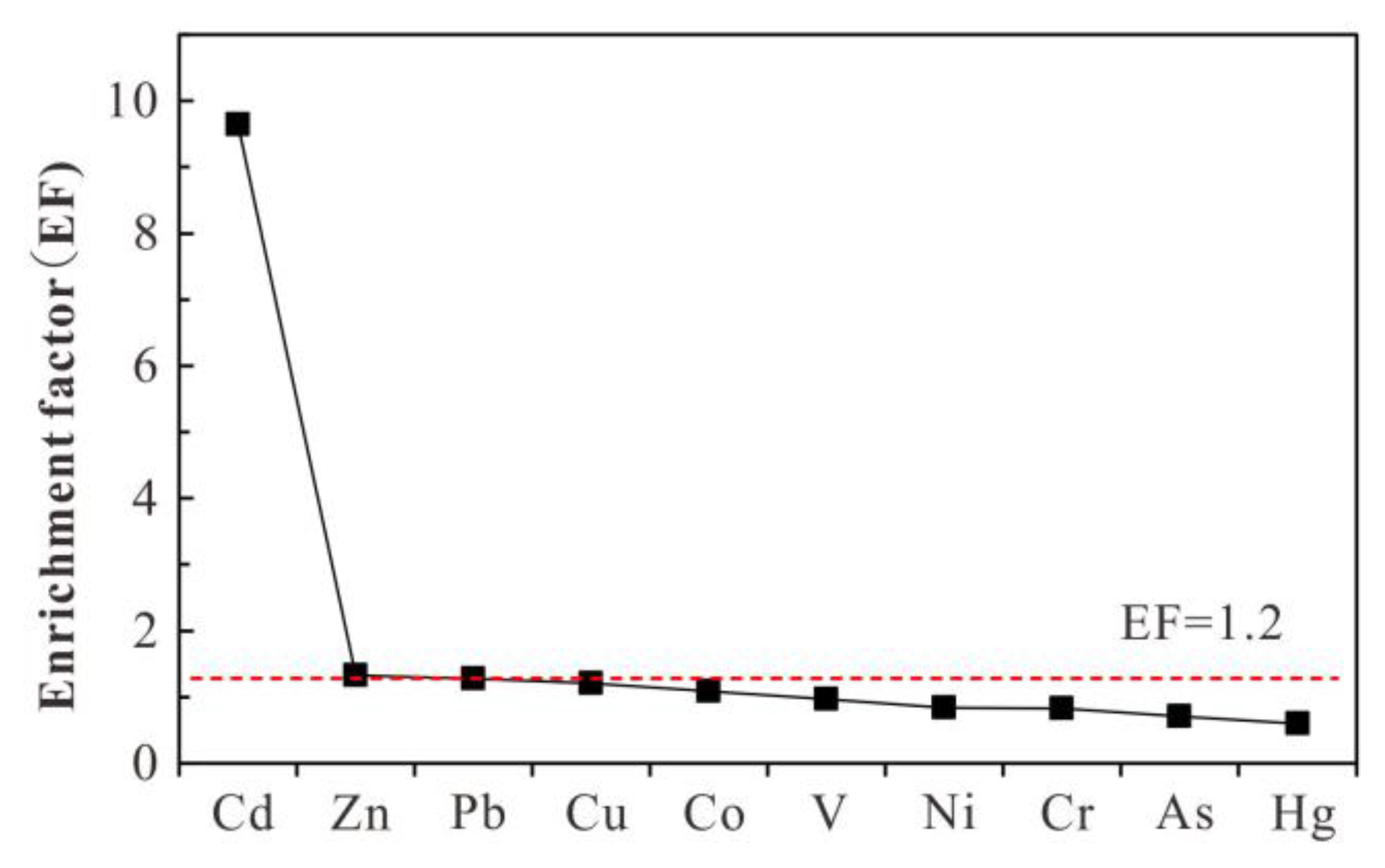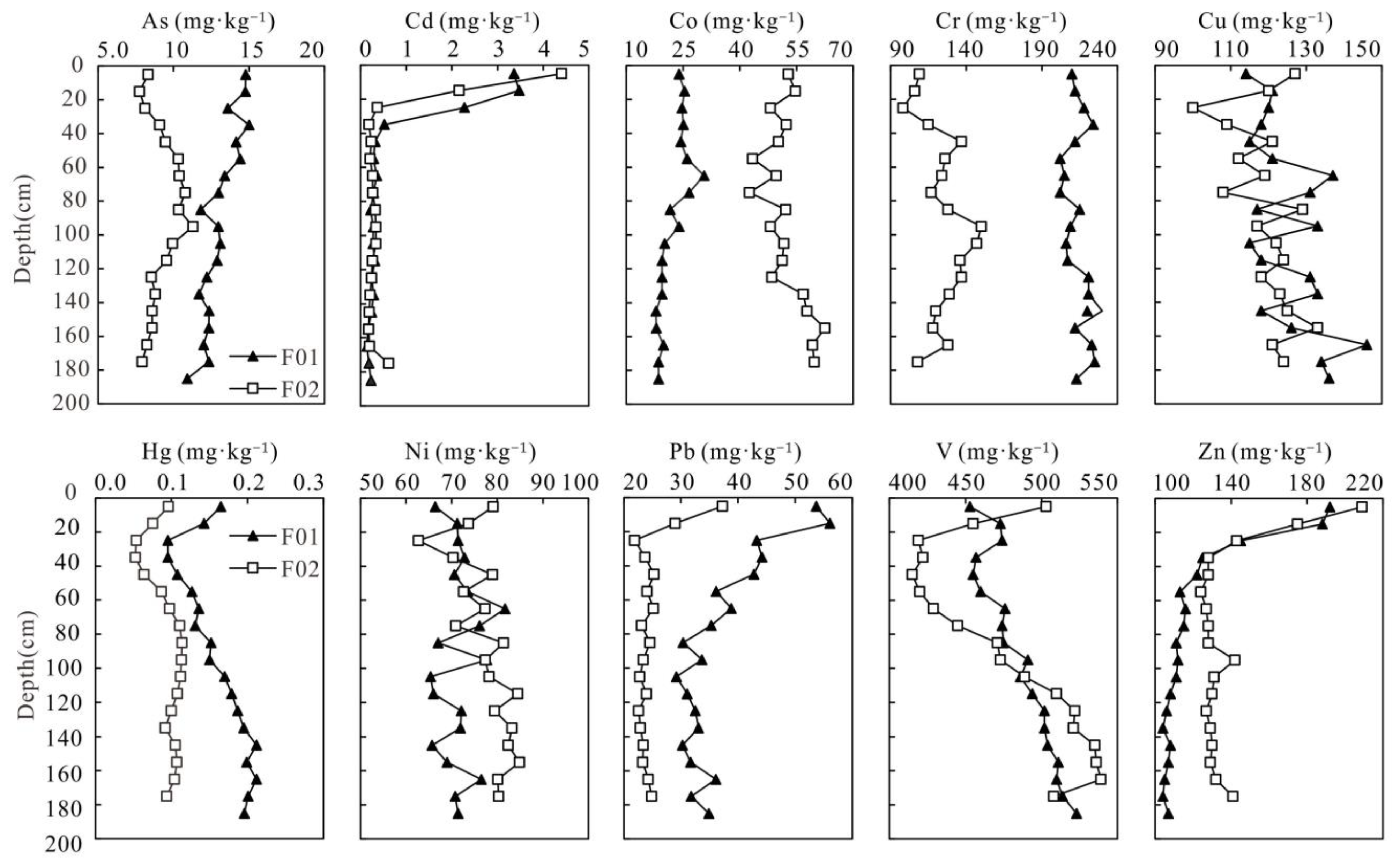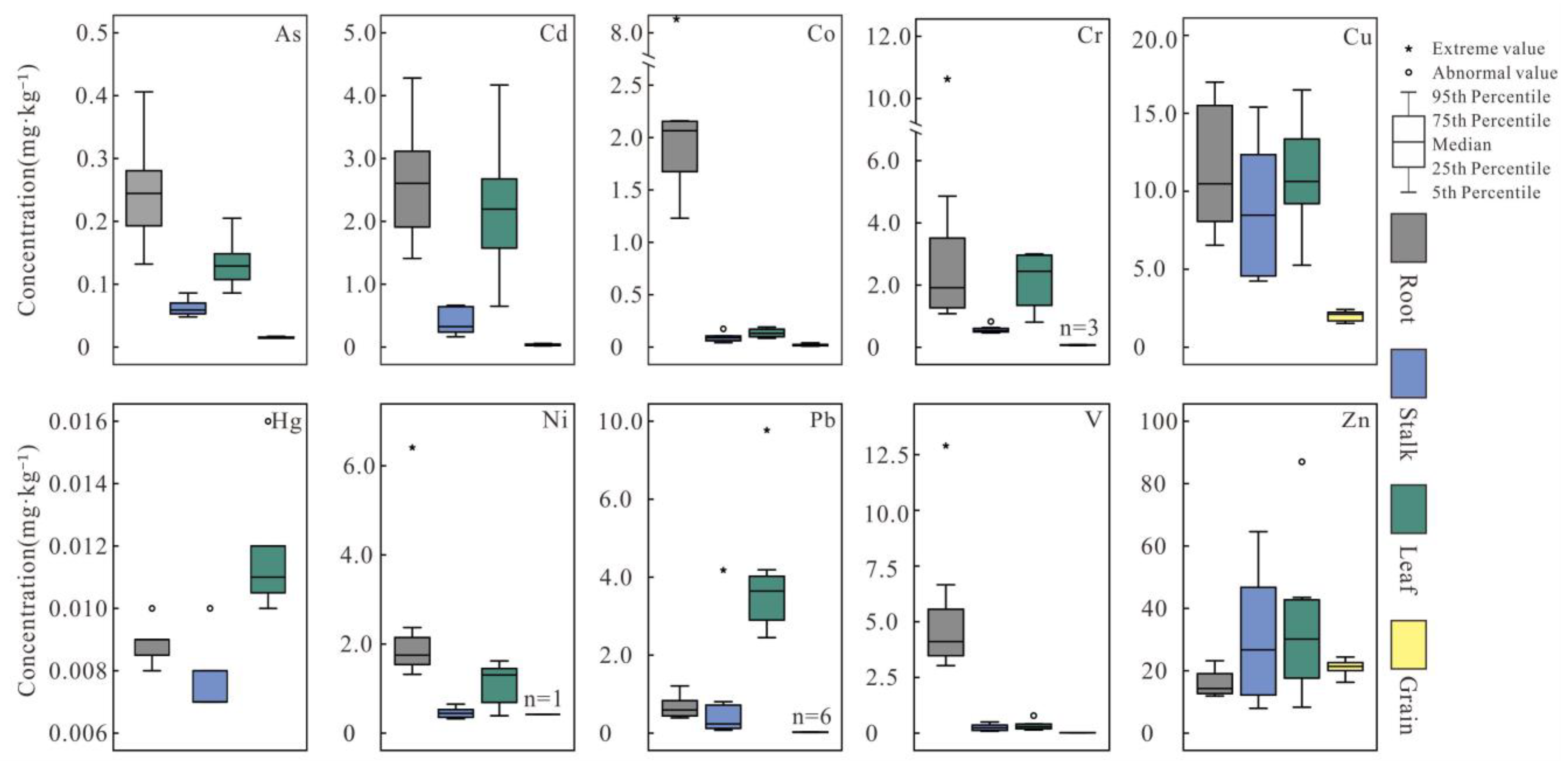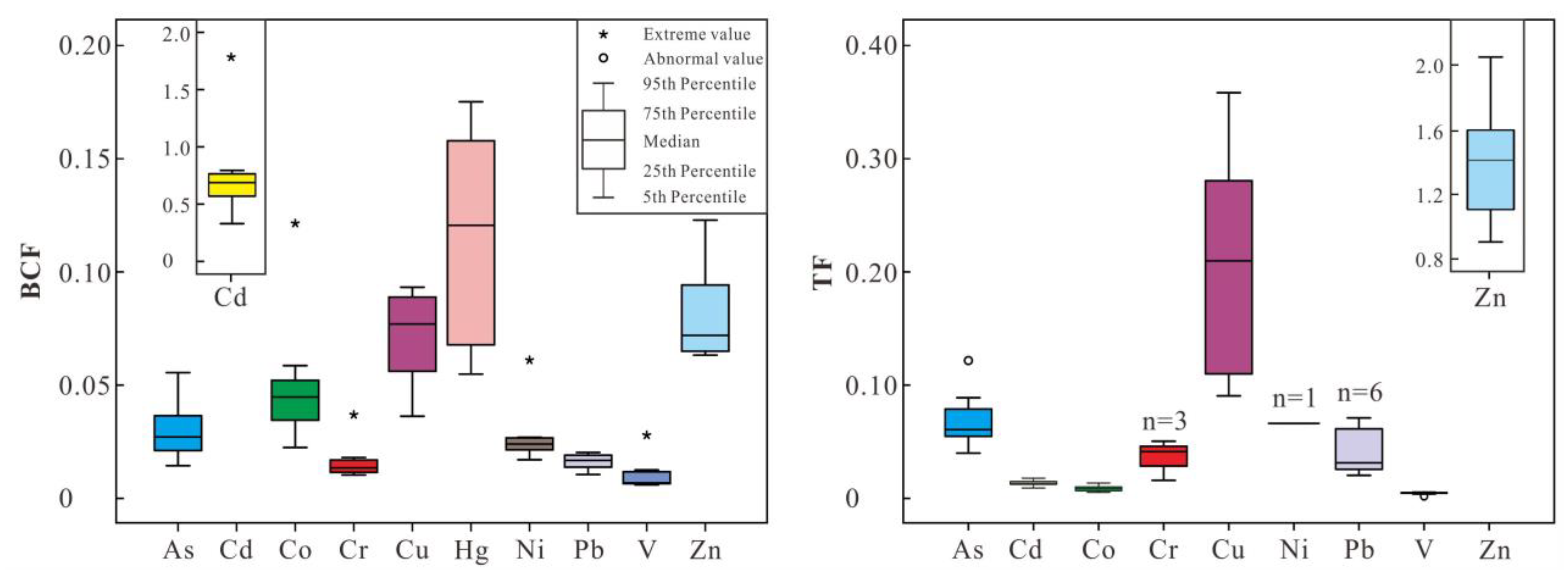Bioavailability, Sources, and Transfer Behavior of Heavy Metals in Soil–Crop Systems from a High Geological Background Area Impacted by Artisanal Zn Smelting in Guizhou Province, Southwest China
Abstract
:1. Introduction
2. Materials and Methods
2.1. Study Area
2.2. Samples Collection and Pre-Treatment
2.3. Analytical Methods and Quality Control
2.3.1. The Total Concentrations of Heavy Metals
2.3.2. Chemical Fractions of Heavy Metals
2.3.3. Quality Control
2.4. Enrichment Factor (EF)
2.5. Bioconcentration Factor and Translocation Factor
2.6. Statistical Analysis
3. Results and Discussion
3.1. Total Concentrations of Heavy Metals in Soils
3.2. Bioavailability of the Heavy Metals in Soils
3.3. Sources of Heavy Metals Pollution
3.3.1. Enrichment Factor
3.3.2. Enrichment Horizon
3.4. Total Concentrations of Heavy Metals in Maize and Potatoes
3.5. Transport of Heavy Metals in Soil–Maize System
4. Conclusions
Author Contributions
Funding
Data Availability Statement
Conflicts of Interest
References
- Hasan, S.A.; Fariduddin, Q.; Ali, B.; Hayat, S. Cadmium: Toxicity and tolerance in plants. J. Environ. Biol. 2009, 30, 165–174. [Google Scholar] [PubMed]
- Raghunath, R.; Tripathi, R.M.; Kumar, A.V.; Sathe, A.P.; Khandekar, R.N.; Nambi, K.S.V. Assessment of Pb, Cd, Cu, and Zn Exposures of 6- to 10-Year-Old Children in Mumbai. Environ. Res. 1999, 80, 215–221. [Google Scholar] [CrossRef]
- Chen, C.J.; Hsueh, Y.M.; Lai, M.S.; Shyu, M.P.; Tai, T.Y. Increased prevalence of hypertension and long-term arsenic exposure. Hypertension 1995, 25, 53–60. [Google Scholar] [CrossRef] [PubMed]
- Järup, L. Hazards of heavy metal contamination. Br. Med. Bull. 2003, 68, 167–182. [Google Scholar] [CrossRef] [PubMed]
- Hooda, P.S. Trace Elements in Soils; Wiley-Blackwell: Chippenham, UK, 2010; 596p. [Google Scholar]
- Hu, Y.N.; Cheng, H.F. A method for apportionment of natural and anthropogenic contributions to heavy metal loadings in the surface soils across large-scale regions. Environ. Pollut. 2016, 214, 400–409. [Google Scholar] [CrossRef]
- Chen, H.Y.; Teng, Y.G.; Lu, S.J.; Wang, Y.Y.; Wang, J.S. Contamination features and health risk of soil heavy metals in China. Sci. Total Environ. 2015, 512–513, 143–153. [Google Scholar] [CrossRef]
- Kaasalainen, M.; Halla, M.Y. Use of sequential extraction to assess metal partitioning in soils. Environ. Pollut. 2003, 126, 225–233. [Google Scholar] [CrossRef]
- Abrahams, P.W. Soils: Their implications to human health. Sci. Total Environ. 2002, 291, 1–32. [Google Scholar] [CrossRef]
- Giller, K.E.; Mcgrath, S.P. Pollution by toxicmetals on agricultural soils. Nature 1988, 335, 676. [Google Scholar] [CrossRef]
- Tessier, A.P.; Campbell, P.G.C.; Bisson, M.X. Sequential Extraction Procedure for the Speciation of Particulate Trace Metals. Anal. Chem. 1979, 51, 844–851. [Google Scholar] [CrossRef]
- Pueyo, M.; López-Sánchez, J.F.; Rauret, G. Assessment of CaCl2, NaNO3 and NH4NO3 extraction procedures for the study of Cd, Cu, Pb and Zn extractability in contaminated soils. Anal. Chim. Acta 2004, 504, 217–226. [Google Scholar] [CrossRef]
- Chen, F.; Wang, Q.; Meng, F.; Chen, M.; Wang, B. Effects of long-term zinc smelting activities on the distribution and health risk of heavy metals in agricultural soils of Guizhou province, China. Environ. Geochem. Health 2020, 45, 5639–5654. [Google Scholar] [CrossRef] [PubMed]
- Li, G.H.; Feng, X.B.; Qiu, G.L.; Bi, X.Y.; Li, Z.G.; Zhang, C.; Wang, D.Y.; Shang, L.H.; Guo, Y.N. Environmental mercury contamination of an artisanal zinc smelting area in Weining County, Guizhou, China. Environ. Pollut. 2008, 154, 21–31. [Google Scholar] [CrossRef] [PubMed]
- Bi, X.Y.; Feng, X.B.; Yang, Y.G.; Qiu, G.L.; Li, G.H.; Li, F.L.; Liu, T.Z.; Fu, Z.Y.; Jin, Z.S. Environmental contamination of heavy metals from zinc smelting areas in Hezhang County, western Guizhou, China. Environ. Int. 2006, 32, 883–890. [Google Scholar] [CrossRef]
- Zhou, Y.T.; Wang, L.L.; Xiao, T.F.; Chen, Y.H.; Beiyuan, J.Z.; She, J.Y.; Zhou, Y.C.; Yin, M.L.; Liu, J.; Liu, Y.Y.; et al. Legacy of multiple heavy metal(loid)s contamination and ecological risks in farmland soils from a historical artisanal zinc smelting area. Sci. Total Environ. 2020, 720, 137541. [Google Scholar] [CrossRef]
- Zhang, Y.P.; Wu, Y.E.; Yang, A.M.; Wang, J.; Zhang, K.K.; Hu, D.Y. Assessment of cadmium content of potato grown in Weining County, Guizhou Province, China. Environ. Monit. Assess. 2017, 189, 226. [Google Scholar] [CrossRef]
- Wei, X.D.; Zhou, Y.T.; Jiang, Y.J.; Tsang, D.C.W.; Zhang, C.S.; Liu, J.; Zhou, Y.C.; Yin, M.L.; Wang, J.; Shen, N.P.; et al. Health risks of metal(loid)s in maize (Zea mays L.) in an artisanal zinc smelting zone and source fingerprinting by lead isotope. Sci. Total Environ. 2020, 742, 140321. [Google Scholar] [CrossRef]
- Yang, Q.Q.; Li, Z.Y.; Lu, X.N.; Duan, Q.N.; Huang, L.; Bi, J. A review of soil heavy metal pollution from industrial and agricultural regions in China: Pollution and risk assessment. Sci. Total Environ. 2018, 642, 690–700. [Google Scholar] [CrossRef]
- Kong, X.Y.; Liu, T.; Yu, Z.H.; Chen, Z.; Lei, D.; Wang, Z.W.; Zhang, H.; Li, Q.H.; Zhang, S.S. Heavy Metal Bioaccumulation in Rice from a High Geological Background Area in Guizhou Province, China. Int. J. Environ. Res. Public Health 2018, 15, 2281. [Google Scholar] [CrossRef]
- DD2005-03; Technical Requirements for Sample Analysis of Ecological Geochemical Assessment. CGS (China Geological Survey): Beijing, China, 2005. (In Chinese)
- Zhang, J.R.; Li, H.Z.; Zhou, Y.Z.; Dou, L.; Cai, L.M.; Mo, L.P.; You, J. Bioavailability and soil-to-crop transfer of heavy metals in farmland soils: A case study in the Pearl River Delta, South China. Environ. Pollut. 2018, 235, 710–719. [Google Scholar] [CrossRef]
- Chen, L.; Wang, G.M.; Wu, S.H.; Xia, Z.; Cui, Z.N.; Wang, C.H.; Zhou, S.L. Heavy Metals in Agricultural Soils of the Lihe River Watershed, East China: Spatial Distribution, Ecological Risk, and Pollution Source. Int. J. Environ. Res. Public Health 2019, 16, 2094. [Google Scholar] [CrossRef] [PubMed]
- Wang, N.N.; Wang, A.H.; Kong, L.H.; He, M.C. Calculation and application of Sb toxicity coefficient for potential ecological risk assessment. Sci. Total Environ. 2018, 610–611, 167–174. [Google Scholar] [CrossRef] [PubMed]
- Sutherland, R.A. Bed sediment-associated trace metals in an urban stream, Oahu, Hawaii. Environ. Geol. 2000, 39, 611–627. [Google Scholar] [CrossRef]
- Blaser, P.; Zimmermanna, S.; Luster, J.; Shoty, K.W. Critical examination of trace element enrichments and depletions in soils: As, Cr, Cu, Ni, Pb, and Zn in Swiss forest soils. Sci. Total Environ. 2000, 249, 257–280. [Google Scholar] [CrossRef]
- Jiang, Y.; Chao, S.H.; Liu, J.W.; Yang, Y.; Chen, Y.J.; Zhang, A.C.; Cao, H.B. Source apportionment and health risk assessment of heavy metals in soil for a township in Jiangsu Province, China. Chemosphere 2017, 168, 1658–1668. [Google Scholar] [CrossRef]
- Zhang, J.; Liu, C.L. Riverine Composition and Estuarine Geochemistry of Particulate Metals in China—Weathering Features, Anthropogenic Impact and Chemical Fluxes. Estuar. Coast. Shelf Sci. 2002, 54, 1051–1070. [Google Scholar] [CrossRef]
- Rezapour, S.; Atashpaz, B.; Moghaddam, S.S.; Kalavrouziotis, I.K.; Damalas, C.A. Cadmium accumulation, translocation factor, and health risk potential in a wastewater-irrigated soil-wheat (Triticum aestivum L.) system. Chemosphere 2019, 231, 579–587. [Google Scholar] [CrossRef]
- CNEMC (China National Environmental Monitoring Center). The Background Concentrations of Soil Elements in China; Chinese Environment Science Press: Beijing, China, 1990. (In Chinese) [Google Scholar]
- GB 15618-2018; Soil Environmental Quality Risk Control Standard for Soil Contamination of Agricultural Land. China Environment Publishing Group: Beijing, China, 2018. (In Chinese)
- Peng, Y.S.; Yang, R.D.; Jin, T.; Chen, J.; Zhang, J. Risk assessment for potentially toxic metal(loid)s in potatoes in the indigenous zinc smelting area of northwestern Guizhou Province, China. Food Chem. Toxicol. 2018, 120, 328–339. [Google Scholar] [CrossRef]
- Cheng, X.F.; Danek, T.; Drozdova, J.; Huang, Q.R.; Qi, W.F.; Zou, L.L.; Yang, S.R.; Zhao, X.L.; Xiang, Y.G. Soil heavy metal pollution and risk assessment associated with the Zn-Pb mining region in Yunnan, Southwest China. Environ. Monit. Assess. 2018, 190, 194. [Google Scholar] [CrossRef]
- Du, F.; Yang, Z.G.; Liu, P.; Wang, L. Accumulation, translocation, and assessment of heavy metals in the soil-rice systems near a mine-impacted region. Environ. Sci. Pollut. Res. Int. 2018, 25, 32221–32230. [Google Scholar] [CrossRef]
- Chu, Z.L.; Lin, C.Y.; Yang, K.; Cheng, H.G.; Gu, X.; Wang, B.B.; Wu, L.L.; Ma, J. Lability, Bioaccessibility, and ecological and health risks of anthropogenic toxic heavy metals in the arid calcareous soil around a nonferrous metal smelting area. Chemosphere 2022, 307, 136200. [Google Scholar] [CrossRef]
- Adamo, P.; Iavazzo, P.; Albanese, S.; Agrelli, D.; Vivo, D.B.; Lima, A. Bioavailability and soil-to-plant transfer factors as indicators of potentially toxic element contamination in agricultural soils. Sci. Total Environ. 2014, 500–501, 11–22. [Google Scholar] [CrossRef]
- He, K.L.; Sun, Z.H.; Hu, Y.N.; Zeng, X.Y.; Yu, Z.Q.; Cheng, H.F. Comparison of soil heavy metal pollution caused by e-waste recycling activities and traditional industrial operations. Environ. Sci. Pollut. Res. 2017, 24, 9387–9398. [Google Scholar] [CrossRef]
- Zhao, K.L.; Liu, X.M.; Zhang, W.W.; Xu, J.M.; Wang, F. Spatial dependence and bioavailability of metal fractions in paddy fields on metal concentrations in rice grain at a regional scale. J. Soils Sediments 2011, 11, 1165–1177. [Google Scholar] [CrossRef]
- Sterckeman, T.; Douay, F.; Proix, N.; Fourrier, H. Vertical Distribution of Cd, Pb and Zn in Soils near Smelters in the North of France. Environ. Pollut. 2000, 107, 377–389. [Google Scholar] [CrossRef]
- Sungur, A.; Soylak, M.; Ozcan, H. Investigation of heavy metal mobility and availability by the BCR sequential extraction procedure: Relationship between soil properties and heavy metals availability. Chem. Speciat. Bioavailab. 2015, 26, 219–230. [Google Scholar] [CrossRef]
- GB2716-2022; Guidance Limit for Foods. Standards Press of China: Beijing, China, 2022. (In Chinese)
- Nicholson, F.A.; Smith, S.R.; Alloway, B.J.; Carlton-Smith, C.; Chambers, B.J. An inventory of heavy metals inputs to agricultural soils in England and Wales. Sci. Total Environ. 2003, 311, 205–219. [Google Scholar] [CrossRef]
- Peng, M.; Zhao, C.D.; Ma, H.H.; Yang, Z.; Yang, Z.F.; Liu, F.; Li, K.; Yang, Z.; Tang, S.Q.; Guo, F.; et al. Heavy metal and Pb isotopic compositions of soil and maize from a major agricultural area in Northeast China: Contamination assessment and source apportionment. J. Geochem. Explor. 2020, 208, 106403. [Google Scholar] [CrossRef]
- Mao, C.P.; Song, Y.X.; Chen, L.X.; Ji, J.F.; Li, J.Z.; Yuan, X.Y.; Yang, Z.F.; Ayoko, G.A.; Frost, R.L.; Theiss, F. Human health risks of heavy metals in paddy rice based on transfer characteristics of heavy metals from soil to rice. Catena 2019, 175, 339–348. [Google Scholar] [CrossRef]






| n = 42 | As | Cd | Co | Cr | Cu | Hg | Ni | Pb | V | Zn | Zr | pH | OM 1 (%) |
|---|---|---|---|---|---|---|---|---|---|---|---|---|---|
| Minimum | 1.7 | 0.7 | 19.3 | 70.2 | 71.6 | 0.028 | 51.0 | 13.1 | 310.0 | 86.8 | 200 | 4.4 | 0.9 |
| Maximum | 16.6 | 6.9 | 120.0 | 287.0 | 386.0 | 0.229 | 121.0 | 62.2 | 721.0 | 239.0 | 659 | 8.0 | 9.6 |
| Mean | 7.0 | 3.5 | 50.7 | 139.4 | 167.0 | 0.090 | 79.6 | 39.8 | 466.0 | 176.9 | 390 | 5.3 | 3.4 |
| Median | 5.8 | 3.4 | 50.2 | 126.0 | 149.0 | 0.082 | 76.9 | 41.2 | 457.5 | 184.0 | 365 | 5.2 | 3.3 |
| Standard deviation | 3.9 | 1.4 | 21.6 | 55.9 | 67.2 | 0.044 | 16.0 | 11.3 | 83.6 | 34.3 | 119 | 0.7 | 1.4 |
| CV 2 (%) | 55.0 | 41.6 | 42.7 | 40.1 | 40.2 | 48.7 | 20.1 | 28.3 | 17.9 | 19.4 | 30.6 | 14.1 | 40.3 |
| Guizhou Province 3 | 20.0 | 0.659 | 19.2 | 95.9 | 32.0 | 0.110 | 39.1 | 35.2 | 138.8 | 99.5 | 238 | 6.2 | 4.3 |
| China 4 | 11.2 | 0.097 | 12.7 | 61.0 | 22.6 | 0.065 | 26.9 | 26.0 | 82.4 | 74.2 | 256 | / | / |
| As | Cd | Co | Cr | Cu | Hg | Ni | Pb | V | Zn | ||
|---|---|---|---|---|---|---|---|---|---|---|---|
| Maize | n 1 | 32 | 32 | 32 | 3 | 32 | 0 | 14 | 12 | 32 | 32 |
| Minimum | 0.014 | 0.004 | 0.009 | 0.054 | 1.2 | — | 0.209 | 0.021 | 0.015 | 13.8 | |
| Maximum | 0.040 | 0.112 | 0.318 | 0.088 | 2.4 | — | 0.800 | 0.030 | 0.043 | 30.0 | |
| Mean | 0.020 | 0.047 | 0.049 | 0.072 | 1.8 | — | 0.393 | 0.026 | 0.028 | 21.2 | |
| Standard deviation | 0.006 | 0.027 | 0.067 | 0.014 | 0.4 | — | 0.168 | 0.003 | 0.007 | 3.3 | |
| Limit 2 | 0.5 | 0.1 | — | 1.0 | — | 0.02 | — | 0.2 | 0.5 | 0.1 | |
| Over-limit rate (%) | 0 | 9.4 | — | 0 | — | — | — | 0 | — | — | |
| Potato | n | 10 | 10 | 10 | 0 | 10 | 0 | 1 | 0 | 10 | 10 |
| Minimum | 0.002 | 0.093 | 0.026 | — | 0.7 | — | 0.297 | — | 0.004 | 3.9 | |
| Maximum | 0.007 | 0.190 | 0.650 | — | 2.2 | — | 0.297 | — | 0.005 | 8.2 | |
| Mean | 0.003 | 0.153 | 0.149 | — | 1.7 | — | 0.297 | — | 0.004 | 4.9 | |
| Standard deviation | 0.001 | 0.031 | 0.177 | — | 0.5 | — | — | — | 0.001 | 1.2 | |
| Limit 2 | 0.5 | 0.1 | — | 0.5 | — | 0.01 | — | 0.2 | — | — | |
| Over-limit rate (%) | 0 | 90.0 | — | — | — | 0 | — | 0 | — | — |
Disclaimer/Publisher’s Note: The statements, opinions and data contained in all publications are solely those of the individual author(s) and contributor(s) and not of MDPI and/or the editor(s). MDPI and/or the editor(s) disclaim responsibility for any injury to people or property resulting from any ideas, methods, instructions or products referred to in the content. |
© 2023 by the authors. Licensee MDPI, Basel, Switzerland. This article is an open access article distributed under the terms and conditions of the Creative Commons Attribution (CC BY) license (https://creativecommons.org/licenses/by/4.0/).
Share and Cite
Ma, H.; Zhao, C.; Zhang, L.; Liu, Z.; Zhang, F.; Wang, H.; Guo, F.; Tang, S.; Yang, Z.; Peng, M. Bioavailability, Sources, and Transfer Behavior of Heavy Metals in Soil–Crop Systems from a High Geological Background Area Impacted by Artisanal Zn Smelting in Guizhou Province, Southwest China. Processes 2023, 11, 2538. https://doi.org/10.3390/pr11092538
Ma H, Zhao C, Zhang L, Liu Z, Zhang F, Wang H, Guo F, Tang S, Yang Z, Peng M. Bioavailability, Sources, and Transfer Behavior of Heavy Metals in Soil–Crop Systems from a High Geological Background Area Impacted by Artisanal Zn Smelting in Guizhou Province, Southwest China. Processes. 2023; 11(9):2538. https://doi.org/10.3390/pr11092538
Chicago/Turabian StyleMa, Honghong, Chen Zhao, Li Zhang, Zhizhuo Liu, Fugui Zhang, Huiyan Wang, Fei Guo, Shiqi Tang, Zheng Yang, and Min Peng. 2023. "Bioavailability, Sources, and Transfer Behavior of Heavy Metals in Soil–Crop Systems from a High Geological Background Area Impacted by Artisanal Zn Smelting in Guizhou Province, Southwest China" Processes 11, no. 9: 2538. https://doi.org/10.3390/pr11092538






